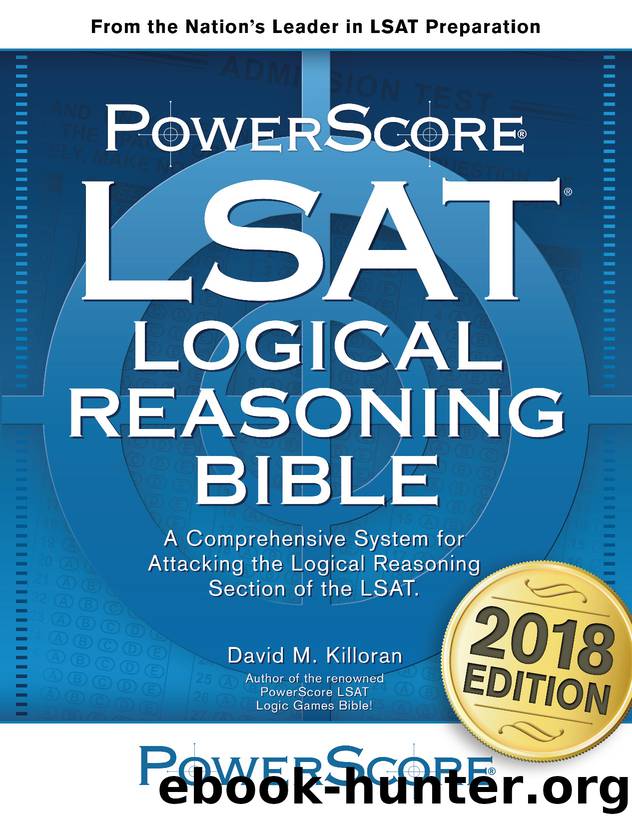The PowerScore LSAT Logical Reasoning Bible by David M. Killoran

Author:David M. Killoran
Language: eng
Format: epub
Tags: powerscore, LSAT, logical reasoning
Publisher: PowerScore Publishing
Published: 2018-03-16T14:56:51+00:00
This relationship is similar to the following:
In this case, a few additional elements have been added to B in the conclusion, but we can add these elements to A and make the problem work. The term that would justify the conclusion in this problem is:
many Justifiably RegrettedForgone
A comparison of this term and answer choice (D) reveals that the two are identical. If you are still uncertain, use the Justify Formula to eliminate each of the remaining answer choices.
In reviewing Justify the Conclusion questions, you must recognize that each of the strategies described in this section are complementary. The approaches work because they all revolve around the undeniable truth of these questions: your answer, when combined with the premises, must justify the conclusion. Whether you see the conditional or numerical basis for the question or use the mechanistic approach is unimportant. The important part is that you quickly determine which answer has the components sufficient to prove the conclusion.
Test Maker Tricks: Justify the Conclusion Questions
The PowerScore Mechanistic Approach has proven so effective that in recent years the test makers have tried to create questions that evade a simple application of the technique. These questions can still be solved by applying the Mechanistic approach (primarily because the theory that underlies that approach is the same theory that is used in the formation of the questions), but it helps if you understand the tricks the test makers are using. There are two primary avenues of deception:
1. Rewording Elements
In most Justify questions, elements are stated in nearly identical terms throughout the argument and the answers. For example, in the previous question in this chapter, the “should not have desired in the first place” element was worded identically in both places it appeared in the argument. This similarity makes it easier to identify and connect elements. Not surprisingly, then, one tool the test makers use is to describe an element in one way when it first appears, and another when it reappears. Here are several examples:
Download
This site does not store any files on its server. We only index and link to content provided by other sites. Please contact the content providers to delete copyright contents if any and email us, we'll remove relevant links or contents immediately.
Cracking the GRE Premium Edition with 6 Practice Tests, 2015 (Graduate School Test Preparation) by Princeton Review(3596)
Kaplan MCAT Organic Chemistry Review: Created for MCAT 2015 (Kaplan Test Prep) by Kaplan(3422)
MCAT Psychology and Sociology Review: New for MCAT 2015 by Princeton Review(2517)
Kaplan MCAT Behavioral Sciences Review: Created for MCAT 2015 (Kaplan Test Prep) by Kaplan(2491)
The Official Guide for GMAT Review 2015 with Online Question Bank and Exclusive Video by Graduate Management Admission Council (GMAC)(2341)
Programming in C (4th Edition) (Developer's Library) by Stephen G. Kochan(1700)
GRE Premier 2017 with 6 Practice Tests by Kaplan(1500)
The PowerScore LSAT Logical Reasoning Bible by David M. Killoran(1448)
MCAT Physics and Math Review 2019-2020 by Kaplan Test Prep(1444)
Peterson's Master the GRE 2014 by Moran Margaret(1429)
GMAT Official Guide 2018 Verbal Review by GMAC (Graduate Management Admission Council)(1384)
MCAT 528 Advanced Prep 2018-2019 by Kaplan Test Prep(1362)
Cracking the LSAT, 2012 Edition by Princeton Review(1342)
GRE-Verbal Behind The Scenes 2014: Discover BTS of ETS (GRE Test Prep) by Bashir Hosseini Jafari(1333)
MCAT Physics and Math Review by Princeton Review(1304)
Text Completion & Sentence Equivalence GRE Strategy Guide by Manhattan Prep(1243)
Kaplan MCAT Critical Analysis and Reasoning Skills Review: Created for MCAT 2015 (Kaplan Test Prep) by Kaplan(1241)
Math Workout for the GRE by Princeton Review(1210)
GMAT For Dummies by Lisa Zimmer Hatch & Scott A. Hatch(1188)
